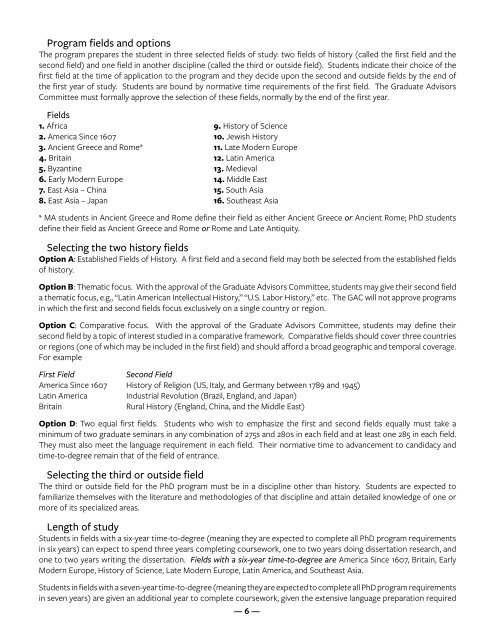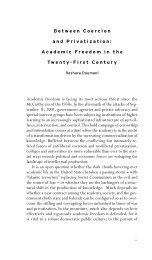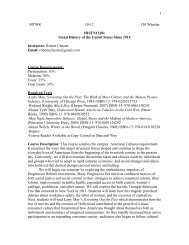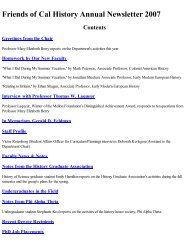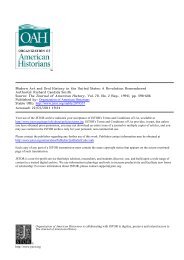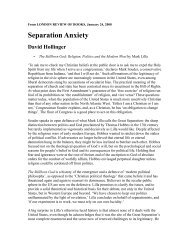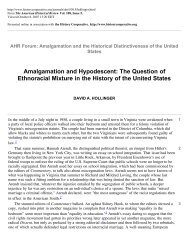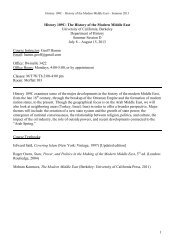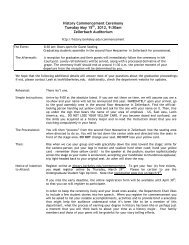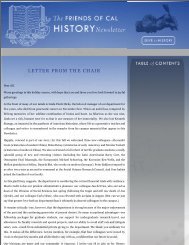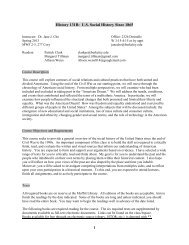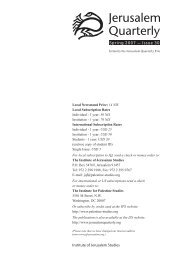Program Guide in PDF Format - Department of History, UC Berkeley
Program Guide in PDF Format - Department of History, UC Berkeley
Program Guide in PDF Format - Department of History, UC Berkeley
- No tags were found...
You also want an ePaper? Increase the reach of your titles
YUMPU automatically turns print PDFs into web optimized ePapers that Google loves.
<strong>Program</strong> fields and optionsThe program prepares the student <strong>in</strong> three selected fields <strong>of</strong> study: two fields <strong>of</strong> history (called the first field and thesecond field) and one field <strong>in</strong> another discipl<strong>in</strong>e (called the third or outside field). Students <strong>in</strong>dicate their choice <strong>of</strong> thefirst field at the time <strong>of</strong> application to the program and they decide upon the second and outside fields by the end <strong>of</strong>the first year <strong>of</strong> study. Students are bound by normative time requirements <strong>of</strong> the first field. The Graduate AdvisorsCommittee must formally approve the selection <strong>of</strong> these fields, normally by the end <strong>of</strong> the first year.Fields1. Africa 9. <strong>History</strong> <strong>of</strong> Science2. America S<strong>in</strong>ce 1607 10. Jewish <strong>History</strong>3. Ancient Greece and Rome* 11. Late Modern Europe4. Brita<strong>in</strong> 12. Lat<strong>in</strong> America5. Byzant<strong>in</strong>e 13. Medieval6. Early Modern Europe 14. Middle East7. East Asia – Ch<strong>in</strong>a 15. South Asia8. East Asia – Japan 16. Southeast Asia* MA students <strong>in</strong> Ancient Greece and Rome def<strong>in</strong>e their field as either Ancient Greece or Ancient Rome; PhD studentsdef<strong>in</strong>e their field as Ancient Greece and Rome or Rome and Late Antiquity.Select<strong>in</strong>g the two history fieldsOption A: Established Fields <strong>of</strong> <strong>History</strong>. A first field and a second field may both be selected from the established fields<strong>of</strong> history.Option B: Thematic focus. With the approval <strong>of</strong> the Graduate Advisors Committee, students may give their second fielda thematic focus, e.g., “Lat<strong>in</strong> American Intellectual <strong>History</strong>,” “U.S. Labor <strong>History</strong>,” etc. The GAC will not approve programs<strong>in</strong> which the first and second fields focus exclusively on a s<strong>in</strong>gle country or region.Option C: Comparative focus. With the approval <strong>of</strong> the Graduate Advisors Committee, students may def<strong>in</strong>e theirsecond field by a topic <strong>of</strong> <strong>in</strong>terest studied <strong>in</strong> a comparative framework. Comparative fields should cover three countriesor regions (one <strong>of</strong> which may be <strong>in</strong>cluded <strong>in</strong> the first field) and should afford a broad geographic and temporal coverage.For exampleFirst FieldSecond FieldAmerica S<strong>in</strong>ce 1607 <strong>History</strong> <strong>of</strong> Religion (US, Italy, and Germany between 1789 and 1945)Lat<strong>in</strong> America Industrial Revolution (Brazil, England, and Japan)Brita<strong>in</strong>Rural <strong>History</strong> (England, Ch<strong>in</strong>a, and the Middle East)Option D: Two equal first fields. Students who wish to emphasize the first and second fields equally must take am<strong>in</strong>imum <strong>of</strong> two graduate sem<strong>in</strong>ars <strong>in</strong> any comb<strong>in</strong>ation <strong>of</strong> 275s and 280s <strong>in</strong> each field and at least one 285 <strong>in</strong> each field.They must also meet the language requirement <strong>in</strong> each field. Their normative time to advancement to candidacy andtime-to-degree rema<strong>in</strong> that <strong>of</strong> the field <strong>of</strong> entrance.Select<strong>in</strong>g the third or outside fieldThe third or outside field for the PhD program must be <strong>in</strong> a discipl<strong>in</strong>e other than history. Students are expected t<strong>of</strong>amiliarize themselves with the literature and methodologies <strong>of</strong> that discipl<strong>in</strong>e and atta<strong>in</strong> detailed knowledge <strong>of</strong> one ormore <strong>of</strong> its specialized areas.Length <strong>of</strong> studyStudents <strong>in</strong> fields with a six-year time-to-degree (mean<strong>in</strong>g they are expected to complete all PhD program requirements<strong>in</strong> six years) can expect to spend three years complet<strong>in</strong>g coursework, one to two years do<strong>in</strong>g dissertation research, andone to two years writ<strong>in</strong>g the dissertation. Fields with a six-year time-to-degree are America S<strong>in</strong>ce 1607, Brita<strong>in</strong>, EarlyModern Europe, <strong>History</strong> <strong>of</strong> Science, Late Modern Europe, Lat<strong>in</strong> America, and Southeast Asia.Students <strong>in</strong> fields with a seven-year time-to-degree (mean<strong>in</strong>g they are expected to complete all PhD program requirements<strong>in</strong> seven years) are given an additional year to complete coursework, given the extensive language preparation required— 6 —


